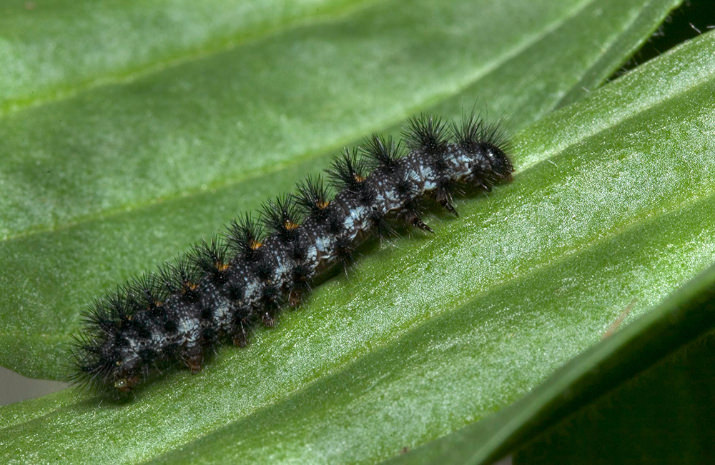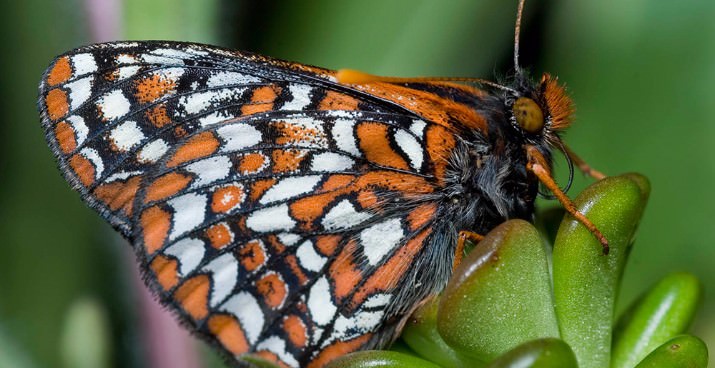Portland, February 24th, 2016. Oregon Zoo conservationists are working to reestablish the dwindling checkerspot populations in central Washington. So they’ve roused more than 1,500 Taylor’s checkerspot larvae from their winter dormancy this month, transferring the very hungry caterpillars into rearing cups at the zoo’s Imperiled Butterfly Conservation Lab, where they munch on narrowleaf plantain following their 7-month snooze.

A newly awakened Taylor’s checkerspot caterpillar munches on narrowleaf plantain in the Oregon Zoo’s butterfly lab. Zoo conservationists recently woke hundreds of the caterpillars from their winter dormancy in preparation for release into the wild. (Photo by Michael Durham, courtesy of the Oregon Zoo.)
This week, Oregon Zoo staffers will join biologists from the Washington Department of Fish and Wildlife to release 1,478 of the growing caterpillars on prairies in central Washington, helping to reestablish populations of checkerspots where some of the region’s best habitat remains. Another 281 larvae will stay behind and complete their transformation into adult butterflies at the zoo — a “rear guard” of sorts that will breed, lay eggs and produce caterpillars for release next year.
“The Taylor’s checkerspot is one of the Northwest’s most beautiful — and most endangered — butterflies,” said Mary Linders, a species recovery biologist with WDFW. “Releasing caterpillars reared at the zoo is part of our ongoing effort to reestablish this imperiled species at sites where it was once abundant. Without large, connected populations, the butterflies struggle to survive.”
The zoo-reared caterpillars will complete their development in the wild, first turning into chrysalides and then — over a span of warm, sunny days this spring — emerging as adult butterflies and unfurling for the first time their distinctive and colorful wings.
Rearing the rare butterflies comes with many challenges. One of the most difficult tasks is feeding the ever-munching larvae, which require vast quantities of specific plants. Thanks to the zoo’s horticulture department, the checkerspot caterpillars are able to feed on narrowleaf plantain, one of the plants their species eats in the wild.
This level of care is crucial: The species is listed under the U.S. Endangered Species Act and, according to Xerces Society for Invertebrate Conservation, is in imminent danger of extinction. Though once abundant across the inland prairies of the Pacific Northwest, the Taylor’s checkerspot has now lost 99 percent of its grassland habitat to agriculture and urban development. And while the butterflies themselves are small, they are important pollinators and have a big impact on their ecosystem.
The Oregon Zoo has raised more than 20,000 checkerspots for release since joining the recovery effort in 2004. After more than a decade of working to increase the endangered butterfly’s numbers, Linders says the effects are becoming noticeable.
“We’ve started seeing Taylor’s checkerspots at locations where they haven’t been documented in years,” Linders said. “It gives us hope for a species that is very close to disappearing completely.”
Committed to butterfly conservation, the Oregon Zoo is a charter member of the Association of Zoos and Aquariums’ Butterfly Conservation Initiative, a collaborative effort among nearly 50 zoos and aquariums. The zoo works in partnership with and receives funding from the Washington Department of Fish and Wildlife and Joint Base Lewis-McChord and its Army Compatible Use Buffer program to rear checkerspots and release them into the wild. Additional project partners include the U.S. Fish and Wildlife Service, the Xerces Society and the Sustainability in Prisons Project administered through The Evergreen State College and Mission Creek Corrections Center for Women.
To learn more about the Oregon Zoo’s effort to save Taylor’s checkerspots and other imperiled Northwest species, visit www.oregonzoo.org/conserve/species-recovery-and-conservation.
The zoo is a service of Metro and is dedicated to its mission of inspiring the community to create a better future for wildlife. Committed to conservation, the zoo is also working to save endangered California condors, Oregon silverspot butterflies, western pond turtles and Oregon spotted frogs. Other projects include studies on Asian elephants, polar bears, orangutans and giant pandas.
Support from the Oregon Zoo Foundation enhances and expands the zoo’s efforts in conservation, education and animal welfare. Members, donors and corporate and foundation partners help the zoo make a difference across the region and around the world.
The zoo opens at 10 a.m. daily and is located five minutes from downtown Portland, just off Highway 26. The zoo is also accessible by MAX light rail line. Visitors who travel to the zoo via MAX receive $1.50 off zoo admission. Call TriMet Customer Service, 503-238-RIDE (7433), or visit www.trimet.org for fare and route information.
General zoo admission is $11.50 (ages 12-64), $10 for seniors (65 and up), $8.50 for children (ages 3-11) and free for those 2 and younger. Additional information is available at www.oregonzoo.org or by calling 503-226-1561.
















